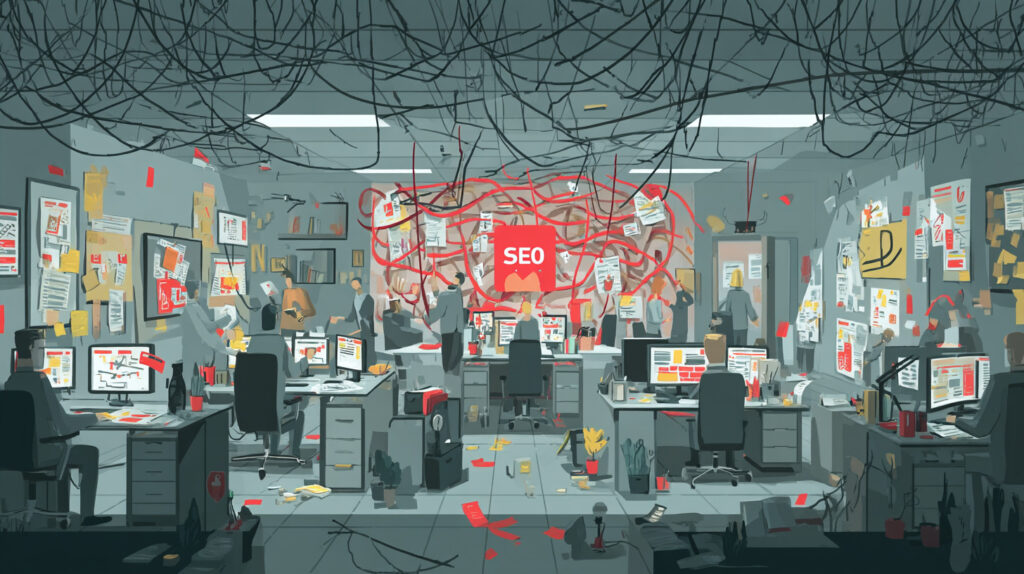Hey there, website creators and digital marketers! Did you know that 75% of users never scroll past the first page of Google search results? That’s why having an SEO-friendly website structure is necessary to boost your visibility and climb those search engine rankings. This year, a well-organised site is more critical than ever for search engine optimisation (SEO). Packed with keywords like “SEO-friendly website” and “improve website ranking,” this article is your friendly guide to building a site structure that Google loves and users find easy to navigate. Let’s dive in and make your website a star performer!
Why Website Structure Matters for SEO
Your website’s structure is like the blueprint of a house—it needs to be solid, logical, and easy to navigate. A good structure helps search engines crawl and index your pages efficiently, ensuring visitors can find what they need without frustration. This year, Google’s algorithms prioritise user experience, rewarding fast, intuitive, and well-organised sites.
A poorly structured site, on the other hand, can confuse Google’s crawlers, bury essential pages, and increase bounce rates (when users leave quickly). Creating an SEO-friendly structure will improve your rankings, drive more traffic, and keep users returning.
Key Elements of an SEO-Friendly Website Structure
Let’s break down the essential components of a website structure that boosts SEO and delights users:
Organise your site like a family tree, with a homepage at the top and categories branching out logically. For example, an e-commerce site might have “Home > Clothing > Men’s > Shirts.” Keep navigation simple with a clean menu, and limit top-level menu items to 5–7 for clarity.
Tip: Use descriptive, keyword-rich menu labels like “SEO Services” or “Digital Marketing Tips” to signal relevance to Google.
2. Flat Architecture
Aim for a “flat” structure where every page is reachable within 3–4 clicks from the homepage. Deeply nested pages are harder for Google to crawl and less likely to rank. For example, instead of “Home > Products > Electronics > Gadgets > Smartphones,” simplify to “Home > Smartphones.”
Tip: Use internal linking to connect related pages, helping Google discover and prioritise your content.
3. Keyword-Optimised URLs
Craft short, descriptive URLs that include target keywords. For instance, “www.example.com/seo-tips” is better than “www.example.com/page123.” Avoid dynamic URLs with random strings (e.g., “?id=456”).
Tip: Use hyphens (not underscores) to separate words, as Google reads them better.
4. Mobile-Friendly Design
With mobile searches surpassing desktop, a responsive design is non-negotiable. This year, Google’s mobile-first indexing means it primarily evaluates your site’s mobile version. Ensure your site adapts seamlessly to all devices, with fast load times and easy navigation.
Tip: Test your site with Google’s Mobile-Friendly Test tool to spot issues.
5. Fast Load Times
Speed is a ranking factor, and slow sites frustrate users. To keep load times under 3 seconds, optimise images, minify CSS/JavaScript, and use a reliable hosting provider.
Tip: Run your site through Google’s PageSpeed Insights for actionable speed recommendations.
6. XML Sitemap and Robots.txt
An XML sitemap lists all your pages, helping Google crawl them efficiently. A robots.txt file tells crawlers which pages to ignore (e.g., admin pages). Submit your sitemap to Google Search Console for better indexing.
Tip: Update your sitemap whenever you add new pages.
Common Mistakes to Avoid
Building an SEO-friendly structure isn’t always smooth sailing. Watch out for these pitfalls:
- Overcomplicated Navigation: Too many menu items or vague labels confuse users and crawlers.
- Broken Links: Dead links harm user experience and SEO. Use tools like Screaming Frog to find and fix them.
- Duplicate Content: Identical pages or thin content can trigger Google penalties. Ensure each page has unique, valuable content.
- Ignoring Mobile Users: A desktop-only site will tank your rankings in today’s mobile-first world.
- Keyword Stuffing: Cramming URLs or content with keywords looks spammy and hurts rankings.
Avoiding these mistakes keeps your site user-friendly and Google-approved.
Benefits of an SEO-Friendly Structure
A well-structured website does more than boost SEO—it transforms your business. This year, sites with clear, crawlable structures are seeing:
- Higher Rankings: Google rewards organised sites with better positions in SERPs.
- More Traffic: Easy navigation keeps users exploring, increasing page views and engagement.
- Lower Bounce Rates: Intuitive design encourages visitors to stick around.
- Better Conversions: A seamless user experience drives sales, sign-ups, or enquiries.
With searches for “website structure for SEO” and “improve site navigation” on the rise, now’s the time to optimise your site.
How to Get Started
Ready to build an SEO-friendly website structure? Follow these steps:
- Audit Your Current Site: Use tools like Google Search Console or Ahrefs to analyse your structure, identify broken links, and spot crawl issues.
- Plan Your Hierarchy: Sketch a logical site map with clear categories and subcategories.
- Optimise URLs: Rewrite URLs to be short, keyword-rich, and descriptive.
- Test Navigation: Ask real users to navigate your site and provide feedback on usability.
- Monitor Performance: Track rankings, traffic, and bounce rates to measure improvements.
If this feels overwhelming, don’t worry—you don’t have to do it alone!
Your Path to an SEO-Friendly Website
Building an SEO-friendly website structure is your ticket to standing out online. Indeed, this year, companies focusing on seamless navigation, lightning-fast load times, and mobile compatibility are seeing impressive rankings and user satisfaction boosts. Whether you’re launching a new site or giving an old one a facelift, a well-planned structure paves the way for lasting success.
Feeling stuck? Reach out to Whizz People for a free consultation! Our friendly SEO specialists will dive into your website, pinpoint areas for enhancement, and help you craft a structure that skyrockets rankings while keeping users happy. Together, let’s create a website that dazzles on Google. Get in touch now!




